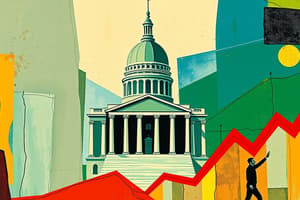Podcast
Questions and Answers
What is a primary purpose of taxation in government?
What is a primary purpose of taxation in government?
- Encouraging consumption of harmful products
- Promoting economic stagnation
- Generating revenue for the government (correct)
- Increasing national debt
Which of the following best describes a regressive tax?
Which of the following best describes a regressive tax?
- It takes a larger percentage from higher income earners
- It takes a higher proportion from lower income earners (correct)
- It takes a constant percentage from all income levels
- It only applies to capital gains
What is the aim of expansionary monetary policy?
What is the aim of expansionary monetary policy?
- To decrease inflation and lower GDP
- To control the money supply by reducing credit
- To increase interest rates and reduce borrowing
- To stimulate economic activity through lower interest rates (correct)
Which of the following is an example of direct taxation?
Which of the following is an example of direct taxation?
How does a proportional tax system function?
How does a proportional tax system function?
What can increasing taxes or reducing spending by the government cause?
What can increasing taxes or reducing spending by the government cause?
Which factor is NOT typically an objective of monetary policy?
Which factor is NOT typically an objective of monetary policy?
What characterizes indirect taxes?
What characterizes indirect taxes?
What is the primary effect of government spending on an economy?
What is the primary effect of government spending on an economy?
What is the purpose of fiscal policy in an economy?
What is the purpose of fiscal policy in an economy?
What results from a government running a budget deficit?
What results from a government running a budget deficit?
What would a government do to change the level of demand using fiscal policy?
What would a government do to change the level of demand using fiscal policy?
Which of the following is not included in the Aggregate Demand formula?
Which of the following is not included in the Aggregate Demand formula?
Which statement accurately defines the concept of the multiplier in economics?
Which statement accurately defines the concept of the multiplier in economics?
What does a budget surplus allow a government to do?
What does a budget surplus allow a government to do?
Which of the following correctly identifies a factor that influences aggregate supply?
Which of the following correctly identifies a factor that influences aggregate supply?
Flashcards are hidden until you start studying
Study Notes
Government Spending and Economic Impact
- Governments utilize funds from taxation and borrowing to finance various projects, significantly impacting the economy.
- Infrastructure projects, such as hospitals, can create jobs for construction companies, leading to increased employment and economic activity.
- Employees in construction generate income, contributing to local businesses and enhancing their revenues through consumer spending.
- Taxation levels influence individual purchasing power; lower taxes allow for greater consumption of goods and services.
- Profit taxes affect the returns on investments for companies, influencing their financial strategies and growth potential.
- Public sector investments support specific industries, e.g., a hospital's need for medical equipment benefits related suppliers.
The Multiplier Effect
- The multiplier principle suggests that an initial economic injection can lead to a multiplied increase in national income.
- Aggregate Demand (AD) represents the total demand for goods and services in an economy, while Aggregate Supply (AS) reflects the economy's production capacity.
- Equilibrium in the national income occurs when the AD curve intersects the AS curve.
- The formula for Aggregate Demand:
- AD = C (Consumption) + I (Investment) + G (Government Spending) + (X - M) (Net Exports).
Fiscal Policy
- Fiscal policy entails government strategies through spending and taxation to modulate economic demand.
- Annual fiscal planning is outlined in budgets, focusing on:
- Expenditure planning
- Revenue generation
- Borrowing strategies
- A budget deficit arises when government spending exceeds tax revenue; a surplus occurs when income surpasses expenditures.
- To stimulate demand, governments can reduce taxes or increase spending; to decrease demand, they can increase taxes or cut spending.
Taxation Dynamics
- Taxation is vital for government revenue, can deter unwanted behaviors (e.g., taxes on tobacco), and redistributes wealth.
- Key characteristics of an effective tax system include flexibility, efficiency, and clear purpose.
- Tax types:
- Direct taxes: Collected directly by tax authorities (e.g., income, capital gains, inheritance taxes).
- Indirect taxes: Collected through third parties (e.g., VAT, sales taxes).
- Specific taxes are charged per item sold, while 'ad valorem taxes' are based on the item's price.
Tax Structures
- Regressive taxes disproportionately impact lower-income individuals, while proportional taxes maintain consistent rates across all income levels.
- Progressive taxes charge higher rates as individuals' incomes increase, typically seen in income tax structures.
- Indirect taxes may be regressive, affecting those who consume necessities heavily.
Monetary Policy
- Focuses on regulating the money supply, interest rates, exchange rates, and credit controls to shape aggregate demand.
- Key objectives include:
- Managing inflation
- Balancing trade (exports vs. imports)
- Full employment: Lower interest rates boost borrowing and job creation.
- Real economic growth: Expansionary policies stimulate economic activity, enhancing GDP.
- Monetary authorities set intermediate targets to achieve these broader economic objectives.
Studying That Suits You
Use AI to generate personalized quizzes and flashcards to suit your learning preferences.




